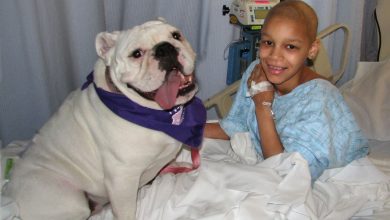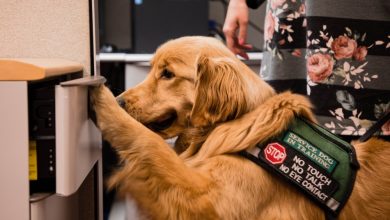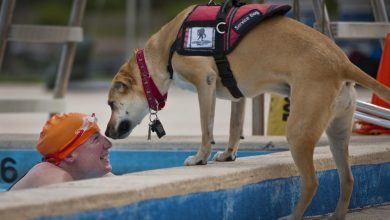Pets & Animals
Is that dog (or pig) on your flight really a service animal?
Ms. Giovinazzo, an Army veteran who lost her sight to multiple sclerosis in 2001, wasn’t having it. Sure, sure, woman,”’ she remembered telling the proprietor. “`Then your animal ought to be secured and trained to not do that. ”’
Ms. Giovinazzo said the dog was an untrained pet masquerading as a service animal in what advocates for individuals with disabilities said had become an increasing problem in the last couple of years.
“It has gotten to the point where it’s almost funny unless you’re the person with the valid guide dog,”
Ms. Giovinazzo stated.Confusion over service dogs, that are specifically trained to help individuals with disabilities, and emotional support animals, which may be pets that provide comfort and companionship but need no instruction, cloud the issue.
Recent headlines about passengers attempting to board flights with what they said were support animals — a peacock in 1 situation and a hamster in a different — as well as national regulations which are subject to misinterpretation or abuse have made things worse, experts said.
Regulators and airlines have taken note.
Delta and Alaska Airlines have tightened their rules for transporting service and support animals, and the national Department of Transportation is researching new rules to decrease the probability that plane passengers claim their pets as service animals. The department intends to solicit public opinion about the”proper definition” of service animals, a spokeswoman said.
Twenty-two states already have some types of laws addressing the problem and lawmakers in Arizona, Iowa and Minnesota are thinking of cracking down on service pet fraud.
The Americans With Disabilities Act defines service animals as either dogs or mini horses which are specifically trained to do work or perform tasks for individuals with disabilities, such as guiding people who are blind. The Air Carrier Access Act separately governs airlines in the field of service and support animals — which is one of those places prone to misuse.
Passengers pass off their pets as support or service animals in order that they can stay in the cabin rather than the cargo hold, officials said. (While unusual pets, like pigs, have been taken aboard as support animals, airlines aren’t required to accommodate others, such as reptiles, snakes, ferrets, snakes and rodents ) The proposal would bar from flights animals whose sole purpose was to offer comfort or emotional support and require federal agencies to set a standard of conduct training for animals that would be working on airplanes, according to a news release.
Chief executive of the National Education for Assistance Dog Services, stated deceptive service or support animals could displace legitimate ones since most airlines limit the amount allowed in a cottage.
A woman attempted unsuccessfully in January to board a flight at Newark Liberty International Airport with a peacock she described as her emotional support animal.CreditThe Jet Set TV/via Reuters
“Before we begin loading up planes with emotional support animals, we need the research,” he said.
Official-looking paperwork is available on the internet to earn pets appear legitimate: Owners answer questions regarding their need for a support creature, and a physician issues an assessment without assessing the customer.
“The whole thing is a mess,” he said, adding that such sites have become a”growth industry” within the previous five decades.
“There are many thoughtless, ignorant or arrogant folks around who just think of themselves,” he said. “Abuse is anywhere.”
Even for trained animals, maneuvering through crowds or travel in restricted places like airplanes can be stressful, but they are conditioned to not act out. Untrained animals in these circumstances are vulnerable to misbehave by growling, biting or with accidents.
Operations administrator at Assistance Dogs International, said one of the worst results may be when a pet posing as a service dog attacks a legitimate one, leaving it traumatized or injured it needs to be retired or put down.
“There are no criteria for assessing the need for an emotional support animal, whereas there are definite rules to find out if a person is eligible for a service animal,” a graduate student in clinical psychology at the department of psychological sciences at the University of Missouri, said in a post on the university’s site.
“But emotional support animals can be certified through an internet process, and they can be someone’s pet,” she continued. “The growing use of emotional support animals tends to ease the use of service animals, which is where a lot of the tension comes from because people don’t understand the difference.”
Additionally, people can shop online for vests, patches or harnesses that identify their pets as service animals, resulting in peculiar situations.
For example, Ms. Giovinazzo, who flies regularly, said airline employees sometimes request identification for Watson. A detailed one issued with his direct school will draw scrutiny, while one which reads”TSA accepted” she purchased from Amazon”appears more official,” she said.
A manager of development at National Education for Assistance Dog Services, shared a photograph taken at Los Angeles International Airport of a dog wearing a vest branded”service animal,” a muzzle and a diaper.
“A genuine service dog would never be muzzled nor would they be in a diaper,” she said.




